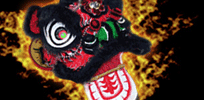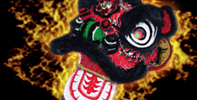

|

|
Welcome! |
 Wednesday, January 7
Wednesday, January 7 |
| WHAT'S HOT |
|
One Week Free Classes & Free Uniform |
| SITE OPTIONS |
 Site Intro Site Intro Guest Book Guest Book Contact Us Contact Us Mailing List Mailing List |
| QUICK LINKS |
 Testimonials Testimonials Coupons Coupons School Location School Location Class Schedule Class Schedule Tien Shan Pai Curriculum Tien Shan Pai Curriculum Wing Chun Curriculum Wing Chun Curriculum Tai Chi Chuan Curriculum Tai Chi Chuan Curriculum Seminars Seminars Event Calendar Event Calendar News News Articles Articles Photo Gallery Photo Gallery Products Products Chinese Terminology Chinese Terminology FAQ FAQ |
| SCHOOL SEARCH |

|
| Home -> Classes -> Southern Kung Fu -> Hung Gar History | ||
|
|
||
Hung Gar History
According to history, South China has been dominated by five Kung Fu styles: Hung, Fut, Choy, lee, and Mok. Hung Gar is the most popular and widespread style. Gar means clan or family in Cantonese Chinese, and Hung refers to the surname of the man who created the system, Hung Hei Gung. The teachings of Hung Gar can be explained by the meaning of the name as Hung means "Stand tall with integrity"Let's look back and see how Hung Gar created such an impact on China's culture and history. Let's pay tribute to these great masters that helped develop Hung Gar and kept the style alive through war and turmoil. Let's learn what sacrifices these masters made, and what took place to develop the most famous southern style of Chinese Gung Fu. Hung Gar Gung Fu is so immersed in China's culture and history that it will always be remembered. Many of China's legendary heroes studied Hung Gar. It's virtues and ideas are still reflected in today's world, never to be forgotten. People such as Wong Fei Hung, Fong Sai Yuk, Tang Fung, and Lam Tsai Wing contributed to making the style what it is today.Hung Gar Gung Fu is a style that was developed at the Sil Lum (Shaolin) Temple. It was founded by a man named Hung Hei Gung. His real surname was Jyu, and he made his living as a traveling tea merchant. One day while traveling, he was confronted by some Ching nobles, who started a fight with him. 
The Ching dynasty was established in 1644 and lasted until 1911, a powerfully oppressive government that crushed the Ming dynasty and caused great turmoil in China. After this incident, Jyu was a wanted man with a price on his head, so he fled to the Sil Lum temple to train as a layman. The Sil Lum temple was known for producing amazing Gung Fu fighters through their extremely hard training at the temple. When Jyu arrived he was taught under the main Sifu at the temple, a man named Gee Sin Sim See.Gee Sin's expertise was the Tiger, and he took student Jyu as one of his special disciples. Jyu trained under Gee Sin Sim See for many years. He worked closely with Hung and helped him to develop the Tiger system. It is said by some Hung Gar practitioners that Gee Sin Sim See was the creator of the Hung style, but this can be argued. Gee Sin Sim See is also noted for helping spread the art of Hung Gar throughout southern China. The training that Jyu Lu Chan at the "Hoi Tong Temple" (Ocean view Temple) endured was incredible, and he was one of the most powerful monks at the temple. Jyu's size and strength well suited the powerful Tiger techniques that Abbott Gee Sin taught him. Jyu's relentless attitude to better himself and others was quickly noticed by everyone around him. He was a proud man with strong virtues, and he had a great desire to show others the skill that he had attained. He studied at the temple for many years, until it was attacked by the oppressive Ching government. The Ching -- or Manchu -- government's attack on the temple was fierce. 
They wanted Gung Fu suppressed because it gave individual people thoughts, rights, and the power to enforce them. The Ching army marched inside the temple and tried to burn it to the ground. They succeeded in destroying the temple, and killing most of its residents, including Gee Sin but Gung Fu survived. Jyu fled the temple and escaped with his life, then changed his name and purpose in life. He changed his name to Hung Hei Gung, and his purpose in life to restoring the Ming dynasty and crushing the Chings. The name change did not represent the style that he would later create, but rather paid tribute to a man he believed in -- Hung Moi Chui, leader of the Ming Dynasty. The Ming Dynasty was a particularly prosperous dynasty that encouraged Gung Fu and was interested in preserving the practices and religions of ancient China. It is said that while on his travels, Hung Hei Gung met another traveling performer -- the lovely Crane Boxer, Fong Wing Chun -- not to be confused with Yim Wing Chun, the founder of Wing Chun/Tsun Gung Fu. It is also said that Fong Wing Chun was the niece of Fong Sai Yuk, though other sources dispute this, and say she was Fong Sai Yuk's daughter. Some accounts say Fong Wing Chun learned her Crane style from Fong Sai Yuk, while other sources indicate that she learned the style from a woman hermit named Mg Mui. The Hung Gar system has five animals: Dragon (Loong), Snake (Sare), Tiger (Fu), Leopard (Pao) and the Crane (Hok).
|
|
|



